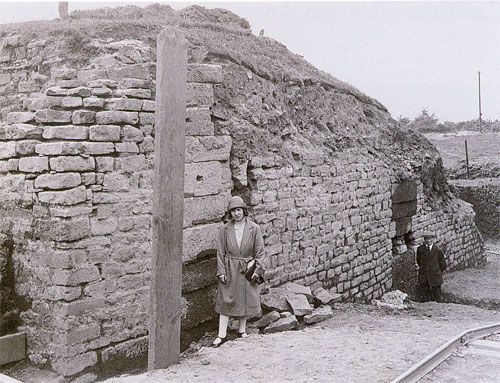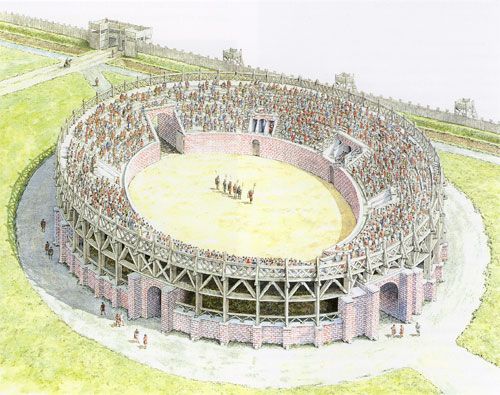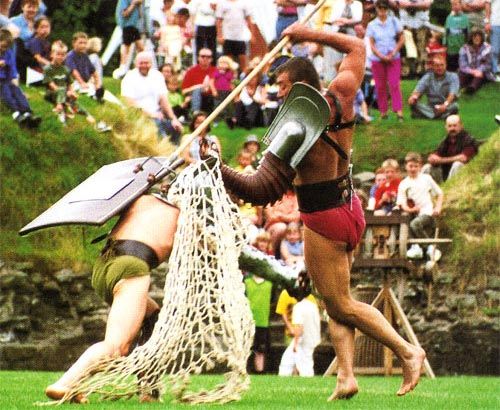Where Gladiators Fought - Discoveries at Caerleon's Roman Amphitheatre

Mrs T. V. Wheeler standing in entrance B of the amphitheatre during its excavation.

Reconstruction of the Caerleon amphitheatre by Alan Sorrell. The amphitheatre is shown as a masonry structure to its full height.

How the amphitheatre may have actually looked. Illustration by Dale Evans (1988) after the reconstruction by R. A. Anderson (1981). Cadw: Welsh Historic Monuments, Crown Copyright.

Re-enactment at Caerleon.
Next to the Roman fortress at Caerleon, near Newport (south Wales), lies the remains of a well-preserved oval amphitheatre, known to local folklore as King Arthur's Round Table. The amphitheatre was excavated in the 1920s by Dr. Mortimer Wheeler, then Director at Amgueddfa Cymru - National Museum Wales. Wheeler's reconstruction of how the amphitheatre may have looked has since been revised as subsequent discoveries have led to a re-think as to how it was constructed.
Securing funds for excavation
Wheeler exploited the connections with King Arthur to drum up sponsorship. The Daily Mail agreed to provide £1,000 for exclusive rights and daily reports on the excavation. The paper eventually trebled its original offer and presented the excavated remains to the then Office of Works (a predecessor of Cadw: Welsh Historic Monuments) as a national monument.
Planning and excavating
In 1926, Wheeler took up the post of Keeper of the London Museum meaning he could not continue his direct involvement with the excavations, but the sponsorship from the Daily Mail made the project binding and urgent, so his wife, Tessa, took over the direction. Every evening a newsworthy story had to be sent to the Daily Mail on the day's discoveries, with 'sensational' headlines such as 'Where Gladiators Fought'.
A structure of earth and masonry
After the excavations were complete and nearly 30,000 tons of soil had been examined and removed from the site, the excavators concluded that the amphitheatre had been constructed around AD 80, several years after the initial foundation of the main fortress at Caerleon. In the report on the findings, published in 1928, the amphitheatre was reconstructed as an earth and masonry structure with the auditorium supported by a bank of earth retained by inner and outer walls of masonry supported and strengthened by buttresses. It was calculated that the original arena wall must have risen to a height of four metres while the external wall must have reached a height of about ten metres. The seats were almost certainly of wood, as no evidence of stone seats was discovered.
In 1939, Alan Sorrell, a well-known painter of archaeological reconstructions shows the amphitheatre built in masonry to its full height.
A new theory
In 1962, George Boon (from the Museum's Department of Archaeology) excavated a small trench in the bank of the amphitheatre, and caused a fundamental re-think of how the superstructure was constructed.
The original surface of the bank was uncovered not far below the turf, this meant that the banks were never higher than they are today. Cut into the surface of the bank were pits, a metre square and deep. Boon concluded that these pits had held large wooden beams forming an openwork timber grandstand. Since this discovery, reconstructions of the amphitheatre have been re-drawn showing its lower part in stone, but with a timber superstructure.
An amphitheatre of similar construction is shown on Trajan's Column at Dobreta, the Roman base on the Romanian side of the Danube bridge.
It has been estimated that the timber grandstand at Caerleon contained 6,000 seats, approximately the full complement of the legion. Events at the amphitheatre, although undoubtedly less bloody, continue to attract large audiences today with exiting re-enactments and other events staged regularly.
Background reading
- Caerleon Roman Fortress by J.K. Night. published by Cadw (2003)
- Isca: The Roman Legionary Fortress at Caerleon, Mon. by G.C. Boon. Published by the National Museum of Wales (1972)
- 'The Roman amphitheatre at Caerleon, Monmothshire' by T.V. -d R.E.M. Wheeler. In Archaeologica vol.78, p.111-218.